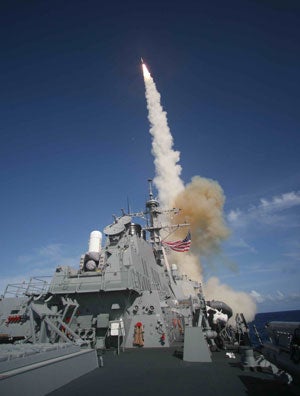Missile Defense: Why It Matters for America’s Future Security
Michaela Dodge / Bryan DeWinter /
Ambassador Robert Joseph, former Under Secretary of State for Arms Control and International Security, recently published an important article in The Washington Times entitled “Obama Chooses Vulnerability.”
As the U.S.commemorated the 10th anniversary since its withdrawal from the 1972 Anti-Ballistic Missile (ABM) Treaty, Ambassador Joseph shares unique insight into lessons learned regarding arms control. A ballistic missile launched from anywhere in the world can reach the U.S. in 33 minutes, as this Heritage documentary shows.
The experience of the U.S. over the past 30 years demonstrates that it is extremely difficult for a country to withdraw from a treaty agreement once it has been ratified. To do so, one must win the intellectual battle of ideas and bust mythology surrounding arms control processes.
Time and again, missile defense opponents have worked to stand in the way of moving forward with robust missile defense deployment and beyond the lingering confines of the abandoned ABM treaty.
A look at history, however, shows that many claims made against missile defense were proven false. Those claims included the assertion that missile defense capabilities would never actually work, but the new advances in ballistic missile defense technology achieved during the last decade dispel that argument.
Today, the Obama Administration is interested in pursuing the “demarcation” agreements with Russia. These agreements would identify the limits between strategic and theater missile defenses and lead to less effective and capable strategic defense systems. Further, President Obama’s recent “flexibility” comment demonstrate a greater interest in placating Russian objections than sufficiently defending Americans at home.
The Obama Administration has also under-funded missile defense programs and cancelled some of the most promising programs in terms of protection against strategic threats: the Multiple Kill Vehicle, Kinetic Energy Interceptor, and Airborne Laser programs.
Iran and North Korea are advancing its long-range ballistic missile programs. In addition, both countries are transferring these technologies to other terrorist organizations, such as Hezbollah. In order to catch up with the advancing ballistic missile threat, the U.S. should:
- Expand and continually improve the Navy’s proven sea-based Aegis missile defense system,
- Pursue and expand advanced integration of the various components of a layered missile defense system, including ground-based interceptors, and
- Develop and deploy space-based missile defenses—particularly space-based interceptors—to counter ballistic missile attacks.
Ambassador Robert Joseph, former Under Secretary of State for Arms Control and International Security, recently published an important article in The Washington Times entitled “Obama Chooses Vulnerability.”
As the U.S.commemorated the 10th anniversary since its withdrawal from the 1972 Anti-Ballistic Missile (ABM) Treaty, Ambassador Joseph shares unique insight into lessons learned regarding arms control. A ballistic missile launched from anywhere in the world can reach the U.S. in 33 minutes, as this Heritage documentary shows.
The experience of the U.S. over the past 30 years demonstrates that it is extremely difficult for a country to withdraw from a treaty agreement once it has been ratified. To do so, one must win the intellectual battle of ideas and bust mythology surrounding arms control processes.
Time and again, missile defense opponents have worked to stand in the way of moving forward with robust missile defense deployment and beyond the lingering confines of the abandoned ABM treaty.
A look at history, however, shows that many claims made against missile defense were proven false. Those claims included the assertion that missile defense capabilities would never actually work, but the new advances in ballistic missile defense technology achieved during the last decade dispel that argument.
Today, the Obama Administration is interested in pursuing the “demarcation” agreements with Russia. These agreements would identify the limits between strategic and theater missile defenses and lead to less effective and capable strategic defense systems. Further, President Obama’s recent “flexibility” comment demonstrate a greater interest in placating Russian objections than sufficiently defending Americans at home.
The Obama Administration has also under-funded missile defense programs and cancelled some of the most promising programs in terms of protection against strategic threats: the Multiple Kill Vehicle, Kinetic Energy Interceptor, and Airborne Laser programs.
Iran and North Korea are advancing its long-range ballistic missile programs. In addition, both countries are transferring these technologies to other terrorist organizations, such as Hezbollah. In order to catch up with the advancing ballistic missile threat, the U.S. should:
- Expand and continually improve the Navy’s proven sea-based Aegis missile defense system,
- Pursue and expand advanced integration of the various components of a layered missile defense system, including ground-based interceptors, and
- Develop and deploy space-based missile defenses—particularly space-based interceptors—to counter ballistic missile attacks.

